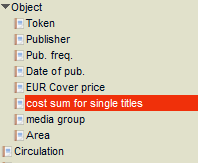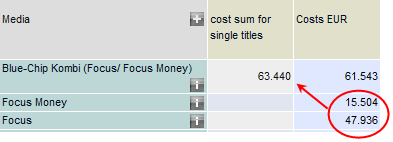Characteristic definitions
|
Frequency |
Number of bookings (editable) | ||
|
Costs |
Price according to the currently-loaded tariff file, shown using the chosen format (editable)
| ||
|
Discount % |
According to the currently-loaded tariff file, shown using the chosen format (editable)
| ||
|
Format |
Tariff sheet with price zone information, discount levels
The tariff sheet provides information about the formats stored for this specific medium in the tariff file, including associated gross prices.
A format other than that set by the basic conditions can be chosen by making an appropriate selection.
| ||
|
max. num. issues |
Magazines: if a planning period has been specified, the maximum number of possible bookings will be displayed | ||
|
Price zone |
Info about price zones in a fixed campaign period
| ||
|
Object |
Media information from the currently-loaded tariff file
Token
(for magazines: CM number) Cost sum for single titles Actual combo costs taken from the tariff file can be compared with the summed costs of the single media. Unlike the Costs characteristic, which factors in possible discounts, the new characteristic supplies the total of the individual costs calculated via the tariff file.
The Blue-Chip combo, consisting of "Focus" and "Focus Money", has a price of € 61,543.00. The cost sum for single titles is € 63,440.00.
For user-defined media combinations, the cost sum always reflects the sum of single title costs.
| ||
|
Circulation |
See chapter on Circulation | ||
|
Circulation CPT |
Costs *1000 = Media plan costs based on circulation, projected to thousands.
| ||
|
Issue circulation |
For issue circulation, the exact circulation figure per issue is reported. If you select multiple weeks for the processing of issue-related circulation, then the average circulation figure is calculated over the selected issues.
| ||
|
Weight |
The media weight serves to factor in the use of the associated medium only to a certain percentage when producing a report. The media weight can take a value between 0 and 100 percent, with the default value set to 100 percent.
If the media weight is set to 50, then the reach is reduced by 50% and the cost per 1000 users doubles.
| ||
|
Media exposure/advertisement exposure
|
The following describes the characteristics for exposure.
If the questionnaire contains advertisement exposures (AEs), then an additional folder is shown with selectable characteristics. Advertisement exposure characteristics are calculated in the same way as media exposure characteristics.
| ||
|
Users % |
Net reach in %
| ||
|
Users m. |
Sum total of persons reached by the media unit with the specified number of bookings selected. The net reach is calculated by determining one person's likelihood of exposure with an average issue/broadcast (e.g. LpA). For a single booking, this is defined as the weighted total of likelihoods for all persons in the target group. For multiple bookings, the internal overlaps are factored in and then eliminated.
| ||
|
Users resp. |
Net reach in resp.
| ||
|
Cost per 1000 users |
Also: Cost per Thousand (CPT). Specifies the sum required to be deployed for an advertising campaign in order to reach 1,000 individuals in a target group.
| ||
|
Affinity |
The affinity equates to the index in the Tabulation: the proportion of the readers in the current target group (i.e. the net reach) is compared with the proportion of the readers in a comparative target group.
| ||
|
Affinity Total |
While the plan value affinity is calculated for the current reference target group, "Affinity Total" always applies to the overall target group. | ||
|
Compos. % |
The readership of the current target group is calculated as a percentage of the readership of the comparative group. The composition can therefore be used to analyse the structure of the readership. Example: "Brigitte", target group "Women", comparative target group "Overall", composition 95.1%, i.e. women make up 95.1% of the readership.
| ||
|
Circu. weighted by target grp. |
| ||
|
Circu. weighted by CPU |
| ||
|
GRP |
(Gross Rating Point). Gross reach in %. Summed figure for exposures without considering overlaps, specified as a percentage value.
| ||
|
Exposures m. |
Total exposures, i.e. the number of all exposures that are achieved by the number of bookings of the media unit. Exposure total = net reach x average number of exposures. For multiple bookings of a medium or multiple media, the individual reach figures are totalled, without taking into account internal and external overlaps.
| ||
|
Exposures resp. |
Gross reach in cases
| ||
|
Average exposures |
Average exposures = average number of exposures that the media audience has with the media unit. Exposure total / net reach
| ||
|
Cost per 1000 users |
Also: Cost per Thousand Users (CPU). Specifies the sum required to be deployed for an advertising campaign in order to reach 1000 exposures in a target group.
| ||
|
Indexes |
In each case, the basis for calculating the index is the best medium for the respective datapoint
| ||
|
Index Users %
|
Basis for calculating the index is the medium with the greatest net reach. The best medium receives an index value of 100; the lower the reach, the lower the index value.
| ||
|
Index CPT
|
Basis for calculating the index is the medium with the lowest Cost per Thousand (€ per thousand users). The medium with the cheapest Cost per Thousand receives the value of 100. As CPT increases, the index value drops.
| ||
|
Index Affinity |
The basis is the medium with the highest affinity; calculated as for Index Users. | ||
|
Index Compos. |
The basis is the medium with the highest user composition; calculated as for Index Users. | ||
|
Index Circu. weighted by Circulation |
The basis is the medium with the highest circulation weighted by target group; calculated as for Index Users. | ||
|
Index GRP |
The basis is the medium with the highest exposure figure; calculated as for Index Users.
| ||
|
Index CPU
|
The basis is the medium with the lowest Cost per Thousand Users. Calculated as for Index CPT. | ||
|
Total index |
The individual indexes reported in the ranking are consolidated into an overall figure.
Total of indexes: all indexes reported in the ranking are summed together. Average of indexes: Total of indexes/number of indexes
Example: "Fernsehwoche" Average of indexes = Index CPT + Index Users % / 2 36 + 32 / 2 = 34 Indexes total = Index CPT + Index Users % 36 + 32 = 68
| ||
|
Ranking |
Ranking position #1 is given to the best medium for each datapoint. The positions are awarded in ascending order. Position #1 is given to the medium with the greatest net reach (ranking Users %), the best-value Cost per thousand (ranking CPT), etc. |









